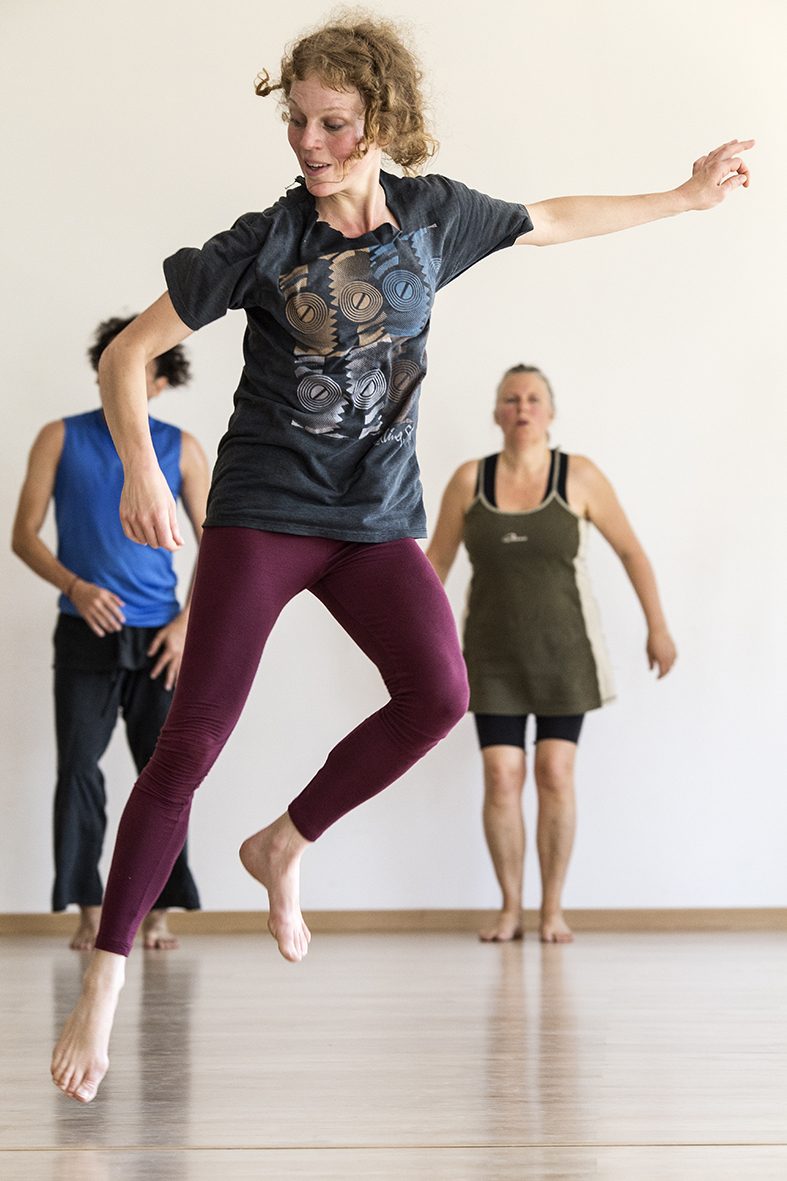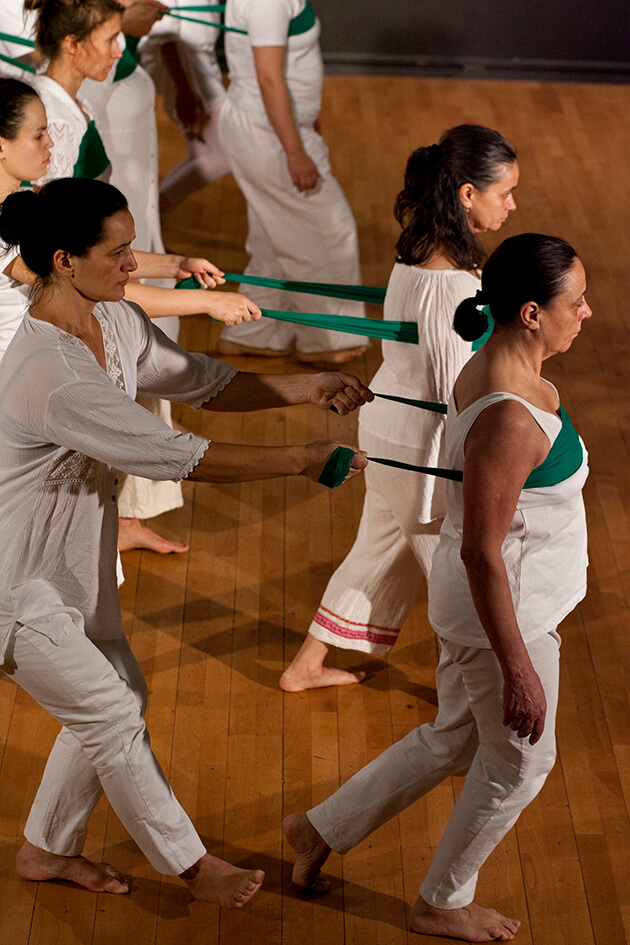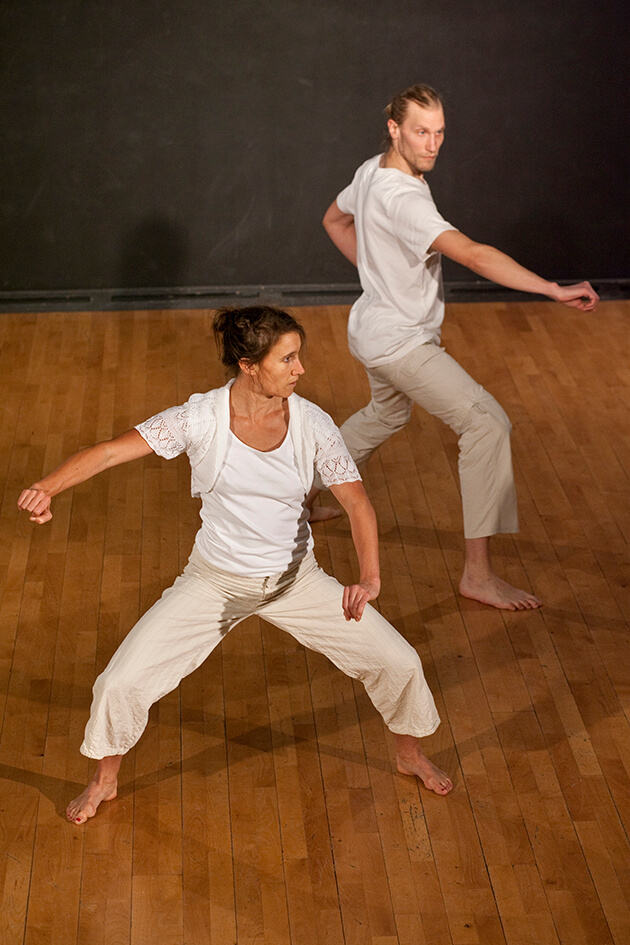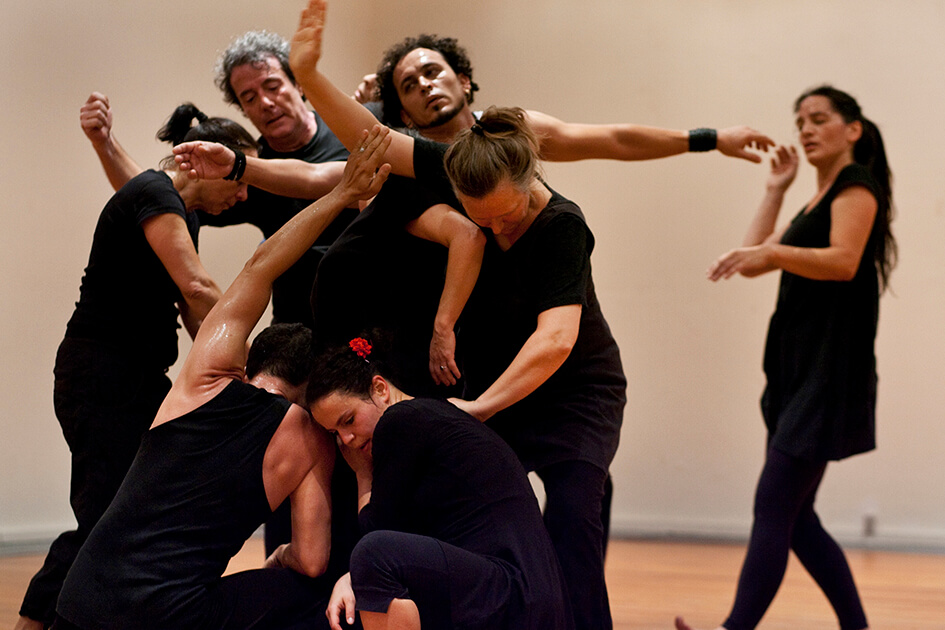THE TRAINING
By Sofia Monsalve
Morning training
During the annual meetings of The Bridge of Winds, members of the group begin their working day with an hour of physical training. This training is the language of the group. The actors can enter the working room after a year of not seeing each other, and do the one-hour structure with perfect communication, as if they had stopped the day before.
The training itself and the collective energy created by the group are more important than the individual expression. The energy may vary, depending on who is training, what mood they are in, how tired or alert they are, but the primary goal is to create a strong unison energy. Being together, synchronizing impulses and actions, becomes more important than showing off personal skills and strengths.

The Master
Iben Nagel Rasmussen observes the training every day, in silence. She makes very few notes, and only after the end of the session she will give a few corrections. The words are carefully selected. Simple, but concrete and precise indications to help the actor find a way to develop the work, to improve the details and qualities.
Although the indications are objective and based on specific observations, they have the ability to open the doors for another kind of knowledge, beyond words. When the actor concentrates on precise details, self-awareness can be expanded, letting organic sensations, memories, and associations appear and take form. Silence is fundamental, and the indications support the actor’s research, without closing the possibilities with ready-made answers or solutions.

The exercises
The Bridge of Winds’ training consists of several different sequences of exercises. The main idea is that different kinds of exercises develop different kinds of energy. The actor comes into possession of a wide spectrum of energetic qualities, which in turn influence the characters he/she creates, and their particular ways of being present on stage.
Each exercise is composed by simple rules and structures, which allow the actor to conduct a deep and long-term research. Carrying out the physical actions and improvising with fixed elements helps to build up a constant flow, where both body and mind are engaged, revealing the actor’s own memories, associations and emotional states.
The Bridge of Winds’ training develops the principles of: transforming weight into energy, alternating the balance (precarious balance), precision of the actions, and relation with the space, rhythm, and the other actors on the floor.
Together, they create a scenic behavior, which obliges the actor to be concrete, effective, and connected with his/her inner paths and energies. The training gives the actor the ability to build structures and physical actions, variations, and to create precise and alive physical sequences (scores).

The Wind Dance
The Wind Dance consists of three fairly simple steps, almost like the waltz, but in which the first step goes down towards the floor with bent knees, in order to take the impulse (sats) and jump in the second step. The third step works as a transition for a new cycle to begin, creating a ternary structure of movement in constant renewal.
This exercise develops a light kind of energy, where the body of the actor is constantly taking off from the floor. Since it is a cyclic exercise, it should be done for a longer time; the objective is not the steps as such, but the “doors” the steps open, allowing the actor to go beyond tiredness and find hidden sources of energy, which is so fundamental for the actor’s work.
The Wind Dance serves as a base. It creates a flow, in which the actor can develop other principles and actions: stops, ways of throwing, catching, and improvising with invisible objects. It is important to keep the flow without interrupting it, in order to let the actions grow from the flow itself, rather than from a preconceived idea. And, last but not least, the actions should always be directed into the space or to the other actors. It becomes a dance of relations.

Green Energy
The Green Energy is inspired by the basic walking technique from Noh theatre, in which the master holds the student’s hips with a belt, in order to create a resistance. The student must walk, while keeping the hips steady and the weight of the body in the center, maintaining the same height while walking, as if gliding on little wheels. The Bridge of Winds has developed this exercise to create a slow, but active energy, and a way of moving in space, as if the air was thick and dense. The simple action of pushing the air creates a contained, but powerful presence.

The Samurai
The Samurai exercises consist of three basic steps, inspired by the image of a Japanese warrior with his heavy armor, ready for battle: wide open legs and a straight torso, while arms and shoulders are relaxed, but ready to react. Holding a long wooden stick with both hands can help the pupil to obtain the position and to focus his/her attention in the space.
After learning the basic steps, each actor can create new forms: jumps, turns, ways of sitting on the floor, etc., and then use these actions like letters of a ”physical alphabet”, improvising their order and qualities. One can compare this process to writing a poem, or telling a story about battles, relations, travels, etc. The Samurai exercises teach the actor to compose in straight lines and angles, constantly transforming weight into energy, being precise, powerful, concrete, and to develop an energy connected to the ground.

Slow Motion
In contrast to the Green Energy, the Slow Motion is a way of moving and acting very slowly, but without resistance, as if the body was under water, or in outer space, with no gravity.
All joints are loose and the movements are wide, slow, and in a continuous flow. Every single muscle is following the imaginary non-gravity and avoiding inorganic tensions. The objective is to find the inner root of the action – all movements are born in the center of the body – and the dilation of time forces the actor to have a total awareness of the body, while finding organic ways to lead the movement.

Out of Balance
In this segment of the training, each actor finds his/her own sequence of exercises, which start with letting the body fall out of its balance, almost to the point of falling to the floor. Just before losing control, he/she has to hold the body back, preserving the energy from the fall, and using it to create a new out-of-balance action. The actor is told to fix the invented exercises and improvise with them, discovering countless ways of making the transition from one to the next. It is important to find the new beginning at each end, in order to use the energy from the fall as the starting point of a new action.
